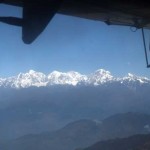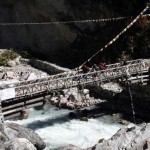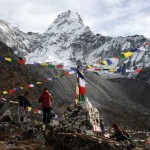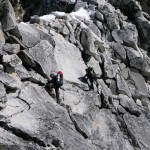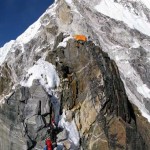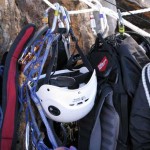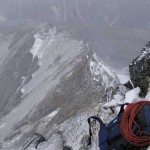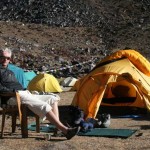Ama Dablam is one of the classic mountains of the Himalayas. It is technical, remote and full of mountaineering challenges. During October and November 2009 I took on the SW Ridge and pushed my climbing to the limit…
Being back in Katmandu always brings with it an air of excitement. Mad driving, streets full of people, the smell of incense (and pollution), noise and a certain Asian feel all mix into one. The streets of Thamel are packed with travelers galore from across the world. Street vendors walk up and down selling anything from harps to drugs – it’s all a bit mad. Thankfully I’m a seasoned traveler, but to new eyes it can all seem a bit much. After a day of orientation, we left the city for quieter climbs…
Lukla has sported an airstrip since the 1960’s and almost all trips into the Kumbu region fly here from Katmandu. The airstrip is built on a slope of around 12% giving a good run downhill fro take off (before you fall over a 2000ft cliff!), and a well needed slope uphill to help stop you at landing. Apparently it’s one of the most dangerous runways in the world. The flight form Katmandu is short and bumpy, but gives fantastic views of the mountains to come (sit on the left going out!) I am very happy on land, but have suffered airsickness since I was a child and was delighted to feel the tyres strike the tarmac safely…
The climbing team brought with it a wealth of experience. Seasoned Alpinists, International Mountaineers and Guides, supported by excellent Climbing Sherpas and Base Camp Staff. It is imperative that people get on quickly and trust each-other. There is little time for argument when the chips are down. Thankfully we all got on like a house on fire and became great friends in the short time we had together. We made a decision early, that whatever happened on the mountain, we would come down as friends…
There is no quick and easy way to get to the mountains. Altitude forces you to take time on your approach to allow your body to catch up. It takes a couple of days to get to Namche Bazaar, then a further two to Base Camp. In-between you need days off to relax, recover and learn to breathe the thinning air. The path was packed with climbers, trekkers and their baggage trains as they headed up and down the mountains. Suspension bridges crossed the rivers every few miles and bounced under the sheer weight of numbers. This was the height of the tourist season!
Namche Bazaar is built in a natural amphitheater at over 3000m (11,000ft). For centuries trading has taken place with Tibetans carrying their good over the Himalayas on Yaks. Originally this was with salt, but now every good you can think of which is ‘Made in China’. The town was abuzz with travelers, traders and tibetans, and has a few gems hidden in the streets. Fresh ground coffee and chocolate cake sit high on my list wherever I am in the world, and in Namche you can eat, drink and watch the world go by. Though rest is needed here, we undertook an acclimatization walk to Kunde and Kumjung before beading off to Ama Dablam Base Camp.
Established on a level plain at 4600m (15,000ft), Base Camp was comfortable, organised and well protected from weather and wind. It is important that Base Camp be well constructed as it is here you plan, organise, rest and retreat to, when on the mountain. The dining tent can become a hive of activity, a kit store, drying room and even a gambling den! We rested here both at the beginning and end of the climb, and in-between load hauling and acclimatisation trips. It gave wonderful respite to us all.
As we approached Base Camp, rumours whispered of an accident where an Austrian climber had suffered severe Frostbite. A shiver ran down my spine and a lonely tear rolled down my right cheek. Memories of my own experiences with the cold would not leave me and a few nightmares haunted my sleep. We later discovered that the climber had suffered a Pulmonary Edema on summit day and hung on the ropes all night awaiting rescue. It took two days to get him to Base Camp, by which time we arrived. I offered my services, but Doctors were already with him and I thought it best to keep out of the way. The next morning a helicopter landed at the camp and a tired looking figure with hands in bags was helped on board and whisked off to Katmandu. What will happen to him, I don’t know, but I pray that he will have excellent medical care and recover well.
Before any climbing takes place, it is important that the expedition, its people and equipment are blessed. A Lama walked to Base Camp from the nearby village of Pangboche and lead the Puja Ceremony. Rice and alcohol were thrown and split as the prayers and scripts were chanted. We all joined in with the chanting and rice throwing, eat and drank, invited onlookers and eventually ran for the dining tent as after almost two hours standing outside we were freezing! Wherever we are in the world we should embrace culture and experience everything we can with reverence and interest.
The SW ridge was a huge undertaking. This Dragons Back of a challenge may have fixed ropes along its length, but the huge exposure and blank rock make for an exciting route. Campsites are difficult to find and two huge towers require either vertical jumars or stiff climbing to attain. Rock gives way to ice as you climb towards Camp 3 and the huge Dablam – a hanging Serac high on the mountain threatens to wipe everything before it, should it fall. It fell in 2006, killing six climbers, but was deemed safe for our ascent. It still makes for an unnerving night as you lie in your tent with it standing above you.
The pinnacle of rock that is Camp 2 is legendary in the climbing world. Its remote location, high on the SW ridge is the only place to pitch a tent. When I say pitch, I mean lay it on the flattest piece of rock you can and rope it to boulders, pinnacles or climbing gear. Walking around camp is hazardous enough, but going to the toilet is an experience all on its own. With multiple expeditions on the mountain it is imperative that they communicate about summit attempts and timings, due to the constrictions at Camp 2. Oh and you can get mobile phone service there!
The wind at Camp 3 howled all night and at times I thought the attempt was off. We did eventually decide to go and began our fight up the fixed ropes. As dawn broke the skies were clear, but a weather front soon reared it’s head and the wind increased. Lightning fast blizzards soon struck, knocking me to my feet and smashing spindrift into my face. I fought slowly on – the rest of the groups pace was too much for me. As I approached the summit I could other members of the team coming down. They looked strong and were heading back to Camp 3 at pace. A meeting then came that I will never forget as I was asked to turn around and head for home as time had ran out and the weather was deteriorating. My emotions fell flat and my soul emptied there and then. Only 150m (490ft) to go out of 6812m (22,349ft), but I had little choice. I was tired and turned my body around. Hoping for a respite at Camp 3, I found it almost destroyed by the wind. The tents were tattered, poles broken and the site inhabitable, so we set off on the long retreat to Camp 2. I felt weaker and weaker as we descended, eventually coming into camp after dark.
When descending, gravity is usually your friend, that is until the anchor you abseil off fails. I was descending from the summit towards Camp 2 when I suddenly felt the abseil rope go very slack. In what felt like slow motion I began to fall backwards and slide down the slope – accelerating as I fell. Above me came the guide as he had been clipped into the same failing anchor. We both skidded down the steep ice and snow, madly trying to stop. After around 80m we slowed and halted through a combination of grabbing other ropes and delicately edging our crampons into the face. There we were, overlooking a huge drop with little purchase in the face. Hyperventilating isn’t pleasant at such heights!
I controlled my breathing and slowly slid across to the abseil route, clipped onto another line and continued my journey down. Within minutes we were laughing about the whole thing..!
It’s always sad to leave the mountains. To turn your back on the peaks and walk downhill marks the end of another trip, but perhaps the beginning of another. My body was physically shattered and I struggled for the three days back to Lukla before we flew into Katmandu. Much was gong through my mind at the time, but it felt hazy and confused. The what ifs’ were raging wild, but in time they passed and now as I sit back in England I can reflect on an incredible experience in the Himalayas. Will I try Ama Dablam agin in the future? I don’t know. 2010 already seems busy and there are so many places on this world I would like to travel to and climb. Time will tell…







